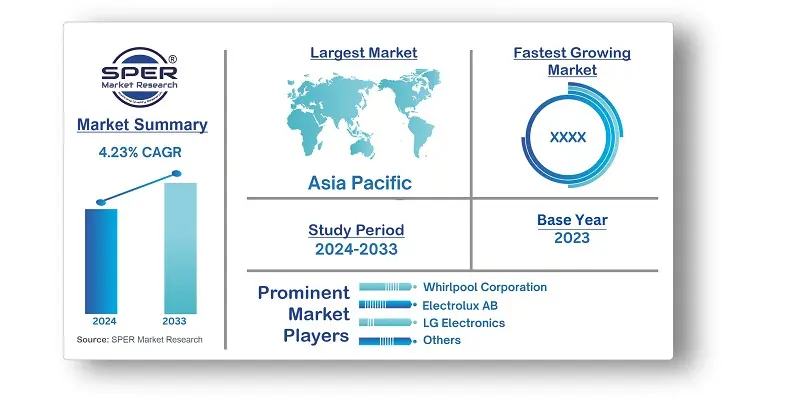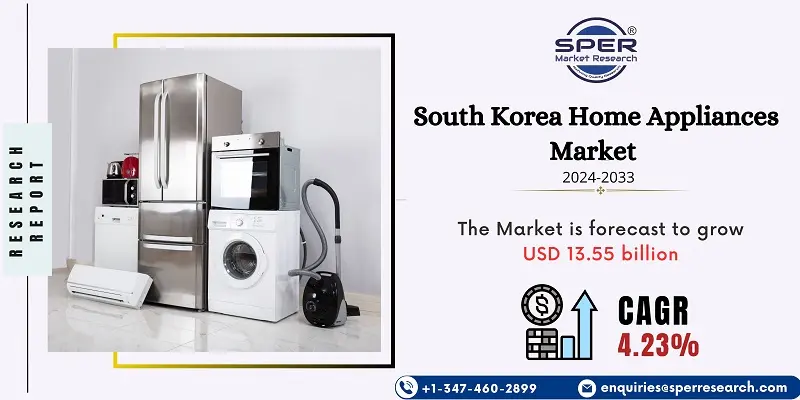
South Korea Home Appliances Market Growth, Size, Trends, Demand, Revenue and Future Outlook
South Korea Home Appliances Market Size- By Product, By Distribution Channel- Regional Outlook, Competitive Strategies and Segment Forecast to 2033
| Published: Jun-2024 | Report ID: IACT24120 | Pages: 1 - 109 | Formats*: |
| Category : Information & Communications Technology | |||
- July 2021 - LG Electronics (LG) and Magna International Inc. (Magna) inked a transaction agreement to form a joint venture. The joint venture brings Magna's capability in electric powertrain systems and world-class automotive manufacturing together with LG's expertise in e-motor and inverter component development.
- July 2021 - Samsung Electronics and Q CELLS established a new strategic alliance, combining their technological skills to create 'zero energy home' solutions. A zero-energy home becomes self-sufficient by solely using energy generated by the home itself. This self-sufficiency is achieved by both producing energy from renewable sources, such as solar, and reducing energy usage by using more efficient technologies.


| Report Metric | Details |
| Market size available for years | 2020-2033 |
| Base year considered | 2023 |
| Forecast period | 2024-2033 |
| Segments covered | By Product, By Distribution Channel |
| Regions covered | Seoul Capital Area, Yeongnam (Southeastern Region), Honam (Southwestern Region), Hoseo (Central Region) |
| Companies Covered | Whirlpool Corporation, Electrolux AB, LG Electronics, Samsung Electronics, Panasonic Corporation, Haier Electronics Group Co Ltd, BSH Hausgeräte GmbH, Arcelik AS, Gorenje Group, Mitsubishi Electric Corporation. |
- Young Professionals and Newlyweds
- Middle-aged Families
- Senior Citizens
- Urban Dwellers
- Eco-conscious Consumers
- Luxury Segment
| By Product: |
|
| By Distribution Channel: |
|
- South Korea Home Appliances Market Size (FY’2024-FY’2033)
- Overview of South Korea Home Appliances Market
- Segmentation of South Korea Home Appliances Market By Product (Major Appliances, Small Appliances)
- Segmentation of South Korea Home Appliances Market By Distribution Channel (Supermarkets and Hypermarkets, Specialty Stores, E-commerce, and Others)
- Statistical Snap of South Korea Home Appliances Market
- Expansion Analysis of South Korea Home Appliances Market
- Problems and Obstacles in South Korea Home Appliances Market
- Competitive Landscape in the South Korea Home Appliances Market
- Impact of COVID-19 and Demonetization on South Korea Home Appliances Market
- Details on Current Investment in South Korea Home Appliances Market
- Competitive Analysis of South Korea Home Appliances Market
- Prominent Players in the South Korea Home Appliances Market
- SWOT Analysis of South Korea Home Appliances Market
- South Korea Home Appliances Market Future Outlook and Projections (FY’2024-FY’2033)
- Recommendations from Analyst
1.1. Scope of the report1.2. Market segment analysis
2.1. Research data source
2.1.1. Secondary Data2.1.2. Primary Data2.1.3. SPER’s internal database2.1.4. Premium insight from KOL’s
2.2. Market size estimation
2.2.1. Top-down and Bottom-up approach
2.3. Data triangulation
4.1. Driver, Restraint, Opportunity and Challenges analysis
4.1.1. Drivers4.1.2. Restraints4.1.3. Opportunities4.1.4. Challenges
4.2. COVID-19 Impacts of the South Korea Home Appliances Market.
5.1. SWOT Analysis
5.1.1. Strengths5.1.2. Weaknesses5.1.3. Opportunities5.1.4. Threats
5.2. PESTEL Analysis
5.2.1. Political Landscape5.2.2. Economic Landscape5.2.3. Social Landscape5.2.4. Technological Landscape5.2.5. Environmental Landscape5.2.6. Legal Landscape
5.3. PORTER’s Five Forces
5.3.1. Bargaining power of suppliers5.3.2. Bargaining power of buyers5.3.3. Threat of Substitute5.3.4. Threat of new entrant5.3.5. Competitive rivalry
5.4. Heat Map Analysis
6.1. South Korea Home Appliances Market Manufacturing Base Distribution, Sales Area, Product Type6.2. Mergers & Acquisitions, Partnerships, Product Launch, and Collaboration in South Korea Home Appliances Market
7.1. South Korea Home Appliances Market Size, Share and Forecast, By Product, 2020-20267.2. South Korea Home Appliances Market Size, Share and Forecast, By Product, 2027-20337.3. Major Appliances
7.3.1. Refrigerators7.3.2. Freezers7.3.3. Dishwashing Machines7.3.4. Washing Machines7.3.5. Cookers and Ovens
7.4. Small Appliances
7.4.1. Vacuum Cleaners7.4.2. Toasters7.4.3. Grills and Roasters7.4.4. Coffee/Tea Makers7.4.5. Mixers and Grinders
7.4.6. Others
8.1. South Korea Home Appliances Market Size, Share and Forecast, By Distribution Channel, 2020-20268.2. South Korea Home Appliances Market Size, Share and Forecast, By Distribution Channel, 2027-20338.3. Supermarkets and Hypermarkets8.4. Specialty Stores8.5. E-commerce8.6. Others
9.1. South Korea Home Appliances Market Size and Market Share
10.1. South Korea Home Appliances Market Size and Market Share By Region (2020-2026)10.2. South Korea Home Appliances Market Size and Market Share By Region (2027-2033)10.2.1. Seoul Capital Area10.2.2. Yeongnam (Southeastern Region)10.2.3. Honam (Southwestern Region)10.2.4. Hoseo (Central Region)10.2.5. Others
11.1. Whirlpool Corporation
11.1.1. Company details11.1.2. Financial outlook11.1.3. Product summary11.1.4. Recent developments
11.2. Electrolux AB
11.2.1. Company details11.2.2. Financial outlook11.2.3. Product summary11.2.4. Recent developments
11.3. LG Electronics
11.3.1. Company details11.3.2. Financial outlook11.3.3. Product summary11.3.4. Recent developments
11.4. Samsung Electronics
11.4.1. Company details11.4.2. Financial outlook11.4.3. Product summary11.4.4. Recent developments
11.5. Panasonic Corporation
11.5.1. Company details11.5.2. Financial outlook11.5.3. Product summary11.5.4. Recent developments
11.6. Haier Electronics Group Co. Ltd
11.6.1. Company details11.6.2. Financial outlook11.6.3. Product summary11.6.4. Recent developments
11.7. BSH Hausgeräte GmbH
11.7.1. Company details11.7.2. Financial outlook11.7.3. Product summary11.7.4. Recent developments
11.8. Arcelik AS
11.8.1. Company details11.8.2. Financial outlook11.8.3. Product summary11.8.4. Recent developments
11.9. Gorenje Group
11.9.1. Company details11.9.2. Financial outlook11.9.3. Product summary11.9.4. Recent developments
11.10. Mitsubishi Electric Corporation*
11.10.1. Company details11.10.2. Financial outlook11.10.3. Product summary11.10.4. Recent developments
11.11. Others
SPER Market Research’s methodology uses great emphasis on primary research to ensure that the market intelligence insights are up to date, reliable and accurate. Primary interviews are done with players involved in each phase of a supply chain to analyze the market forecasting. The secondary research method is used to help you fully understand how the future markets and the spending patterns look likes.
The report is based on in-depth qualitative and quantitative analysis of the Product Market. The quantitative analysis involves the application of various projection and sampling techniques. The qualitative analysis involves primary interviews, surveys, and vendor briefings. The data gathered as a result of these processes are validated through experts opinion. Our research methodology entails an ideal mixture of primary and secondary initiatives.



Frequently Asked Questions About This Report
PLACE AN ORDER
Year End Discount
Sample Report
Pre-Purchase Inquiry
NEED CUSTOMIZATION?
Request CustomizationCALL OR EMAIL US
100% Secure Payment






Related Reports
Our Global Clients
Our data-driven insights have influenced the strategy of 200+ reputed companies across the globe.




















